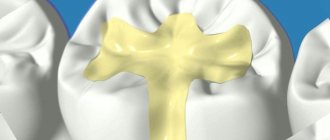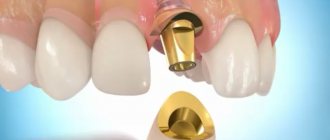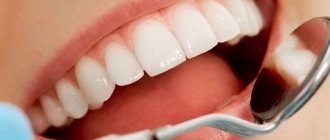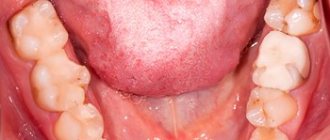- Features of light seals
- When to eat mono after filling?
- What products should you be careful with?
- What complications can there be?
- If the seal falls out or is damaged
In modern dentistry, when reconstructing teeth with composite materials, preference is given to light fillings, which have many advantages over the classic filling composition. A light filling is more convenient to install, less toxic, resistant to heavy loads, looks more natural, and can even match the color of tooth enamel. However, in order to maintain the result achieved by the specialist and not provoke separation of the composite, the recommendations of the attending physician should be followed. One of the main questions that patients ask is when can they eat after a light tooth filling and are there any dietary restrictions in the future.
How is a light seal different from a regular one?
In fact, the term “light filling” is more popular among the people, but experts usually use other names: photopolymer, light-curing, heliopolymer are the most common of them. A light filling is a fairly plastic material, and thanks to ultraviolet light it is much easier for a specialist to carry out a filling. This is the main difference between a light filling and a regular one. In addition, you can choose many colors and shades for a light filling, which is why it is so often used in the treatment and restoration of teeth in the smile area. In short, the main advantages of a light filling are reliability, durability and high aesthetics. These qualities make light-based dental fillings one of the most sought after in the dental market.
Indications and contraindications
There are a number of indications for which the use of photopolymer materials is used. The main ones:
- tooth fracture;
- change in color of enamel that cannot be bleached:
- significant defects of tooth enamel;
- the presence of large fillings in the cervical area;
- noticeable interdental gaps;
- the need for minor correction of the position of the teeth;
- damage to the crown by a maximum of forty percent.
Even if there are indications for installing a filling, a specialist may refuse to carry out the necessary treatment. Among the main contraindications for installation are the following:
- bruxism;
- severe destruction of the front teeth;
- active development of caries;
- teeth subjected to intensive fluoride treatment;
- lack of proper oral hygiene.
Some of the contraindications are classified as conditional. Over time, they can be eliminated, and, accordingly, there will no longer be barriers to installing fillings made of photopolymer materials.
Composition of the light seal
The vast majority of filling types are based on the use of a mixture of several materials. A filling made from a light-curing composite has a rather complex composition, which is partly why it costs more than its analogues.
Light seal materials
- Heliocomposite.
The basis of a light filling, which under the influence of an ultraviolet lamp breaks down into radicals, due to which polymerization (hardening) of the filling material occurs. - Filler.
This can be silicon dioxide, glass ceramics, etc. The structure, color and area of application of the filling depend on the type of filler. - Connecting elements.
Advantages and disadvantages
The demand for photopolymer fillings is due to a number of their advantages. The main ones are the following:
- it is possible to accurately restore the relief and shape of teeth even in cases where they are too damaged;
- the filling is combined with hard tissue into a single whole thanks to a special adhesive system;
- after hardening, the material becomes durable, securely bonded to the enamel, and resistant to cracking;
- it is possible to achieve the desired cosmetic effect by selecting the desired color shade of the material;
- installation is carried out by applying the composite layer by layer, thereby creating an imitation of natural dental tissues;
- preparation of cavities and defects is reduced to a minimum;
- In case of delamination or chipping, adhesive correction is possible.
Among the disadvantages of such fillings, one can highlight only shrinkage of the composite when exposed to light and insufficient polymerization. The polymer does not harden completely, and therefore the original shade may change over time.
Photopolymer fillings have many advantages, which is why they are most often used in dentistry. This is a reliable type of dental restoration, with the help of which it is possible to give even severely damaged hard tissues a natural appearance.
Another peculiarity of the use of light composites is that the material hardens only under the influence of a special lamp. Accordingly, the specialist has the opportunity to clearly recreate the natural shape of the tooth, which is very difficult when using other materials.
Types of light seals
Some sources indicate that only anterior teeth can be restored using light-curing composite fillings, but this is incorrect information. Today, such filling is successfully used in all departments, except for the most inaccessible places (for example, “wisdom teeth”). All types of light fillings differ in the composition of the filler, which determines their characteristics.
| Light fillings for teeth | Description | Application area |
| Macro-filled light fillings (light fillings for chewing teeth) | The filler consists of solid large particles (macrophiles). They give the filling strength, but have a rough surface and tend to lose color. | Macrophilic light fillings are usually used on posterior teeth or on the inside of the dentition, where aesthetics are less important. |
| Microfilled light fillings (light fillings for front teeth) | Fillers consisting of small particles. They hold color well, can be polished, but are very fragile. | Mostly used in the smile area. |
| Nanohybrid | They consist of ultra-fine particles that are both durable and aesthetic. | Universal light fillings that can be used in all types of restorations. |
Life time
The service life of photopolymer fillings largely depends on the quality of the material and the competence of the specialist. In addition, the patient himself is able to both shorten and significantly extend the service life of the filling.
The materials used in the filling process can be either highly durable or less reliable. Provided that a high-quality composite is used, it can last up to seven years.
There are cases when the filling falls out almost immediately after its installation. There may be several reasons for this. It is possible that when filling, the doctor made a mistake, as a result of which the material was not securely fixed. The most common cause is adhesion failure due to saliva or liquid.
Find out why a tooth hurts after filling
In such cases a guarantee is issued. Within a year after the filling is installed, the patient can apply for a repeat procedure. There is no charge for the service.
It is also possible that the patient simply did not follow all medical recommendations. In this case, you also need to seek help from a specialist. It is advisable to give preference to those clinics that have only positive recommendations. In this case, the risk of the filling falling out will be minimal.
Installation of a light seal
Today, a light filling can be installed in almost any clinic. Installation has approximately the same number of steps as in the case of other types of fillings (with the exception of scanning with an ultraviolet lamp).
- Initial consultation, panoramic x-ray.
- Anesthesia.
- Preparation of damaged tooth tissues. During depulpation, the canals are treated and a temporary filling is installed.
- Placing a light filling (filling the area with filling material and giving it a primary shape).
- Polymerization of the filling under the influence of ultraviolet light.
- Grinding and finishing of the filling to achieve optimal shape and correct occlusal contact.
If after filling with a light filling your tooth hurts for more than three days or you feel discomfort when closing your jaws, contact your doctor as soon as possible. Find a trusted clinic where you can get a filling in Moscow on Startsmile.ru in the “Search for dentists” section
Advantages and disadvantages of photopolymer fillings
Due to the peculiarities of the composition of composite photopolymer fillings, they have a whole range of advantages that make them the best material for restoring the function and aesthetics of teeth. The main advantages include:
- High quality of fixation on natural dental tissues - withstands strong mechanical loads and is resistant to temperature effects;
- Good plasticity – allows the doctor to effectively fill hard-to-reach areas of the teeth;
- Resistance to pigments – has increased resistance to various dyes, retains the original color for many years;
- Instant drying - the filling dries in a few seconds (under the influence of light rays of a certain spectrum);
- Aesthetic qualities - after treating the surface with special polishing attachments, a specific shine characteristic of natural tooth enamel is achieved.
This filling material has practically no disadvantages in comparison with analogues, with the exception of a higher cost. Therefore, before carrying out the procedure, it is worth checking with the doctor how much a light-curing filling costs in a particular case. Note! The price of a light-curing filling depends on a number of factors: the type of composite, its volume and the complexity of installation.
How much does it cost to install a light seal?
In order to most accurately tell you how much it costs to get a light filling, you need to understand what type of filling will be installed, as well as where exactly the treatment will take place. The cost of a light filling in a state clinic starts from 900 rubles. As a rule, this is a medium quality composite material intended for the restoration of chewing teeth. In private dental clinics in Moscow, the price of a light filling starts from 1,500 – 2,000 rubles. Light fillings for front teeth are more expensive: for aesthetic restorations, the price can exceed 3,000 rubles.
How to install a photopolymer filling
The installation of a photopolymer filling is carried out in an equipped dental office, in several key stages:
- Initial appointment – the doctor examines the patient’s oral cavity, assesses the current condition of the teeth, and decides on the need for filling;
- Damaged tissue is removed - a comprehensive cleaning of the area is carried out for the subsequent installation of a filling;
- Selecting the color of the material – the filling material is selected according to a special scale; it must match the color of the natural enamel of the patient’s other teeth;
- Preparing the tooth for filling - the cleaned tooth is dried and treated with special compounds to improve the quality of adhesion to the polymer;
- Installing a filling - the doctor gradually applies a photopolymer composition into the space to be filled, securing each layer with ultraviolet exposure;
- Treatment of a hardened filling - the anatomical shape is adjusted, the bite is restored and the surface is polished.
The installed photopolymer filling does not require special care. Moreover, in the first days after installation, doctors recommend refraining from drinking staining water and food, and also reducing the mechanical load on the area of the installed filling during eating. Answering the question: after installing a light-curing filling, how long after can you eat? Experts note that a full meal can be taken 2-3 hours after the procedure.
Prosthetics using photopolymers
Large fillings are called microprostheses; they help restore the complete appearance of a damaged tooth.
If the dental crown is destroyed, but the root remains, you can insert a special pin and build up photocomposite material on it. A small miracle occurs: a man-made dental crown is born. For such direct reconstruction as tooth augmentation with photopolymer, the price will be lower than for indirect prosthetics.










